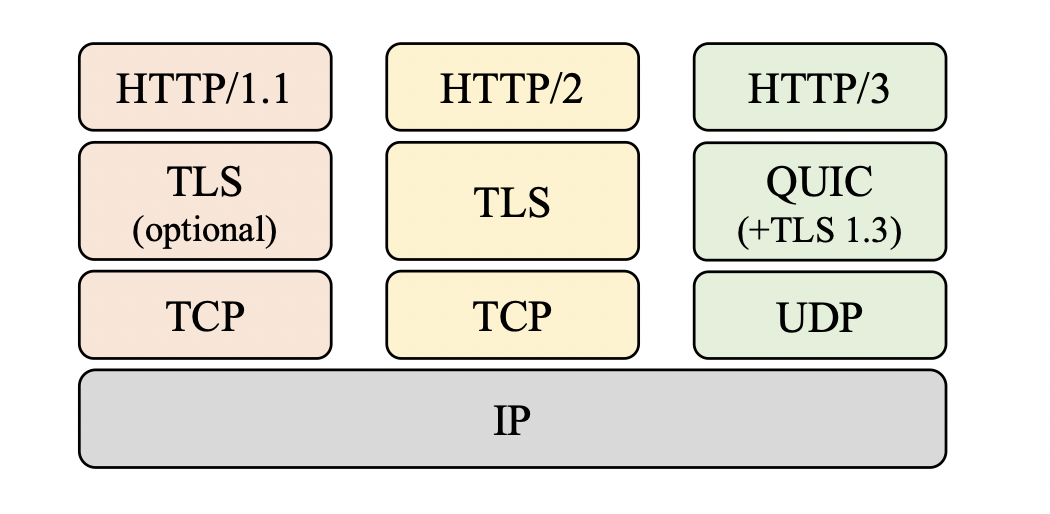The Evolution of HTTP: From HTTP/1.1 to HTTP/2 to HTTP/3
The Hypertext Transfer Protocol (HTTP) is the backbone of the World Wide Web, facilitating the transfer of data between clients and servers. Over the years, HTTP has undergone significant transformations to address the evolving needs of the internet. Let’s explore the journey from HTTP/1.1 to HTTP/2 and the latest, HTTP/3.
HTTP/1.1: The Foundation of the Web
HTTP/1.1, introduced in 1997, became the standard protocol for web communication and has served the internet for over two decades. This version brought several enhancements over its predecessor, HTTP/1.0, such as persistent connections, chunked transfer encoding, and more efficient caching mechanisms.
Key Features of HTTP/1.1:
- Persistent Connections: Enabled the reuse of a single connection for multiple requests, reducing latency.
- Chunked Transfer Encoding: Allowed data to be sent in chunks, enabling the transmission of dynamically generated content.
- Improved Caching: Enhanced mechanisms for caching responses, improving performance and reducing server load.
Despite these improvements, HTTP/1.1 had limitations, particularly in handling multiple simultaneous requests. The need for multiple TCP connections to fetch various resources led to inefficiencies and latency issues.
HTTP/2: A Leap Forward
In 2015, HTTP/2 was standardized, marking a significant evolution in web communication. HTTP/2 aimed to address the performance limitations of HTTP/1.1 while maintaining backward compatibility.
Key Features of HTTP/2:
- Multiplexing: Allowed multiple requests and responses to be sent simultaneously over a single TCP connection, reducing latency and improving page load times.
- Header Compression: Used HPACK compression to reduce the size of headers, decreasing the amount of data transmitted.
- Binary Protocol: Transmitted data in binary format, making it more efficient to parse and less error-prone.
- Stream Prioritization: Enabled clients to prioritize important resources, ensuring critical assets are loaded first.
- Server Push: Allowed servers to send resources proactively before the client requests them, improving load times.
HTTP/2 significantly enhanced performance by addressing the head-of-line blocking issue inherent in HTTP/1.1 and reducing latency through multiplexing. However, it still relied on TCP, which introduced its own set of challenges.
HTTP/3: The Future of Web Communication
HTTP/3, standardized in June 2022, represents the latest advancement in HTTP. It builds on the lessons learned from HTTP/2 and introduces a new transport protocol, QUIC, developed by Google.
Key Features of HTTP/3:
- QUIC Transport Protocol: Uses UDP instead of TCP, reducing connection setup time and avoiding head-of-line blocking at the transport layer.
- Integrated Security: Combines the handshake and encryption setup, enhancing security and reducing latency.
- Improved Multiplexing: Eliminates head-of-line blocking within streams, providing smoother and faster data delivery.
- Enhanced Reliability: Manages packet loss more efficiently, ensuring reliable and consistent performance.
By leveraging QUIC, HTTP/3 offers substantial improvements in performance, reliability, and security. The reduced connection setup time and better handling of packet loss make it particularly well-suited for modern web applications that demand low latency and high efficiency.
Conclusion
The evolution from HTTP/1.1 to HTTP/2 and HTTP/3 reflects the continuous efforts to enhance the performance, reliability, and security of web communication. Each version has addressed the limitations of its predecessor, paving the way for a faster and more efficient internet.
HTTP/1.1 laid the foundation, HTTP/2 introduced significant performance improvements, and HTTP/3 is set to revolutionize web communication with its adoption of QUIC. As the internet continues to evolve, so too will the protocols that underpin it, ensuring that web communication remains robust and efficient in an ever-changing digital landscape.
